Sharjah Sustainable City: An Analytic Hierarchy Process Approach to Urban Planning Priorities
Abstract
1. Introduction
2. Materials and Methods
2.1. Sustainable City Urban Planning Techniques
2.2. Hierarchical Structure of Evaluation Elements
2.3. Research Subject and Method
2.4. AHP Analysis
- Constructing a hierarchical structure: The planning elements, organized into five sectors (spatial system, transportation system, environment/conservation/recycle, energy/building, and parks/green areas), were structured hierarchically with upper and lower criteria based on the sustainable urban planning elements presented.
- Pairwise comparison matrix: Participants conducted pairwise comparisons between elements (criteria) at each level of the hierarchy. They compared the relative importance of each pair of criteria within the same level of the hierarchy. Participants provided their judgment on a scale of 1 to 9, where 1 indicates equal importance, and 9 indicates an extreme difference in importance.
- Calculating the local priority: After obtaining the pairwise comparison matrix, the local priority or weight of each criterion was calculated using the Eigenvalue method. This calculation process involves normalizing the matrix and determining the average of each row, which represents the local priority or weight for each criterion.
- Calculating the global priority: The global priority or weight of each criterion was calculated by multiplying the local priority of each criterion in the hierarchy by its parent criterion’s local priority. The results were then added up for each element at the same level of the hierarchy. This calculation helps in determining the overall importance of each planning element in the context of the final goal.
- Consistency check: To ensure the reliability of the AHP analysis, a consistency check was performed by calculating the consistency ratio (CR). The CR is the ratio of the consistency index (CI) to the random consistency index (RI), where CI is calculated using the largest eigenvalue of the pairwise comparison matrix, and RI is the average consistency index of randomly generated pairwise comparison matrices for a given matrix size. A CR value less than or equal to 0.1 indicates an acceptable level of consistency in the pairwise comparisons.
3. Results
4. Discussion
- Broaden stakeholder input: Incorporate diverse perspectives from residents, policymakers, and other stakeholders, in addition to urban planning experts. This will provide a more comprehensive and nuanced understanding of the priorities and needs of an energy-saving city.
- Examine different urban contexts: Investigate the applicability of the identified planning factors across various urban settings with unique socio-economic, cultural, and environmental conditions. This will help identify context-specific priorities and strategies for different urban environments.
- Employ qualitative methodologies: Utilize qualitative research methods, such as case studies or interviews, to capture the complexities and interdependencies of various planning elements. This will provide a deeper understanding of the underlying processes, challenges, and opportunities in implementing energy-saving urban planning initiatives.
- Investigate the importance of greenways and water-friendly spaces: Explore factors contributing to the relatively low importance of these planning elements in the current study compared to previous research. Identify ways to better integrate these elements into the overall planning and development of energy-saving cities.
5. Conclusions
Author Contributions
Funding
Institutional Review Board Statement
Informed Consent Statement
Data Availability Statement
Acknowledgments
Conflicts of Interest
Appendix A. AHP Survey for Sustainable Urban Planning Priorities
| Gender | Male ( ) Female ( ) |
| Age Group | 20–29 ( ) 30–39 ( ) 40–49 ( ) 50–59 ( ) Above ( ) |
| Period of work experience | Less than 3 years ( ) 4–6 years ( ) 7–9 years ( ) More than 10 years ( ) |
| Occupation Group | Architectural Design ( ) Construction ( ) Urban Design/Planning ( ) Landscape Design ( ) |
| Occupation | Architecture/Urban Design Professor ( ) Construction/Real estate development and sales–related positions ( ) Research institutes and academic associations ( ) |
Appendix A.1. Upper Criteria for Sustainable Urban Planning Elements
| Criteria 1 (Sector) | Criteria 2 (Planning Elements) | |
|---|---|---|
| Spatial System | SS01 | Eco-friendly Density Management |
| SS02 | Inducing Mixed-Use Development | |
| SS03 | Enhancing Accessibility (Securing the Adequacy of the Neighborhood Area) | |
| Transportation System | TS01 | Public Transportation-Oriented Development |
| TS02 | Urban Planning on Green Transportation (Bicycles and Pedestrian Roads) | |
| TS03 | Introduction of New Transportation (Monorail, Electric Vehicle, etc.) | |
| Environment/Conservation/Recycle | EC01 | Reduction of Trash and Food Waste and Establishment of a Recycling System |
| EC02 | Establishment of a Greywater Management System | |
| EC03 | Creation of Hydrophilic for the Water Circulation System | |
| Energy/Building | EB01 | Use Renewable Energy (Solar Power, Geothermal Heat, and Wind Power) |
| EB02 | Expansion of Cogeneration (Energy and Cooling supply) | |
| EB03 | Energy-efficient Building Design (Insulation and Natural Light) | |
| Park/Green Area | PG01 | Creation of Low-Carbon Natural Parks and Green Spaces |
| PG02 | Building Greening (Green Roof, Green Wall, and Green Artificial Ground) | |
| PG03 | Establishment of Accessible Greenways and Green Matrix in residential Areas |
| Criteria | Very Important | Important | Little Important | Equal | Little Important | Important | Very Important | Criteria |
|---|---|---|---|---|---|---|---|---|
| Spatial System | ④ | ③ | ② | ① | ② | ③ | ④ | Transportation System |
| Spatial System | ④ | ③ | ② | ① | ② | ③ | ④ | Environ-ment/Conservation/Recycle |
| Spatial System | ④ | ③ | ② | ① | ② | ③ | ④ | Energy/Building |
| Spatial System | ④ | ③ | ② | ① | ② | ③ | ④ | Park/Green Area |
| Transportation System | ④ | ③ | ② | ① | ② | ③ | ④ | Environment/Conservation/Recycle |
| Transportation System | ④ | ③ | ② | ① | ② | ③ | ④ | Energy/Building |
| Transportation System | ④ | ③ | ② | ① | ② | ③ | ④ | Park/Green Area |
| Environment/Conservation/Recycle | ④ | ③ | ② | ① | ② | ③ | ④ | Energy/Building |
| Environment/Conservation/Recycle | ④ | ③ | ② | ① | ② | ③ | ④ | Park/Green Area |
| Energy/Building | ④ | ③ | ② | ① | ② | ③ | ④ | Park/Green Area |
Appendix A.2. Lower Criteria (Spatial System) for Sustainable Urban Planning Elements
| Criteria | Very Important | Important | Little Important | Equal | Little Important | Important | Very Important | Criteria |
|---|---|---|---|---|---|---|---|---|
| Eco-friendly Density Management | ④ | ③ | ② | ① | ② | ③ | ④ | Inducing Mixed-Use Development |
| Eco-friendly Density Management | ④ | ③ | ② | ① | ② | ③ | ④ | Enhancing Accessibility (Securing the Adequacy of the Neighborhood Area) |
| Inducing Mixed-Use Development | ④ | ③ | ② | ① | ② | ③ | ④ | Enhancing Accessibility (Securing the Adequacy of the Neighborhood Area) |
Appendix A.3. Lower Criteria (Transportation System) for Sustainable Urban Planning Elements
| Criteria | Very Important | Important | Little Important | Equal | Little Important | Important | Very Important | Criteria |
|---|---|---|---|---|---|---|---|---|
| Public Transportation-Oriented Development | ④ | ③ | ② | ① | ② | ③ | ④ | Urban Planning on Green Transportation (Bicycles and Pedestrian Roads) |
| Public Transportation-Oriented Development | ④ | ③ | ② | ① | ② | ③ | ④ | Introduction of New Transportation (Monorail, Electric Vehicle, etc.) |
| Urban Planning on Green Transportation (Bicycles and Pedestrian Roads) | ④ | ③ | ② | ① | ② | ③ | ④ | Introduction of New Transportation (Monorail, Electric Vehicle, etc.) |
Appendix A.4. Lower Criteria (Environment/Conservation/Recycle) for Sustainable Urban Planning Elements
| Criteria | Very Important | Important | Little Important | Equal | Little Important | Important | Very Important | Criteria |
|---|---|---|---|---|---|---|---|---|
| Reduction of Trash and Food Waste and Establishment of a Recycling System | ④ | ③ | ② | ① | ② | ③ | ④ | Establishment of a Greywater Management System |
| Reduction of Trash and Food Waste and Establishment of a Recycling System | ④ | ③ | ② | ① | ② | ③ | ④ | Creation of Hydrophilic for the Water Circulation System |
| Establishment of a Greywater Management System | ④ | ③ | ② | ① | ② | ③ | ④ | Creation of Hydrophilic for the Water Circulation System |
Appendix A.5. Lower Criteria (Energy/Building) for Sustainable Urban Planning Elements
| Criteria | Very Important | Important | Little Important | Equal | Little Important | Important | Very Important | Criteria |
|---|---|---|---|---|---|---|---|---|
| Use Renewable Energy (Solar Power, Geothermal Heat, and Wind Power) | ④ | ③ | ② | ① | ② | ③ | ④ | Expansion of Cogeneration (Energy and Cooling supply) |
| Use Renewable Energy (Solar Power, Geothermal Heat, and Wind Power) | ④ | ③ | ② | ① | ② | ③ | ④ | Energy-efficient Building Design (Insulation and Natural Light) |
| Expansion of Cogeneration (Energy and Cooling supply) | ④ | ③ | ② | ① | ② | ③ | ④ | Energy-efficient Building Design (Insulation and Natural Light) |
Appendix A.6. Lower Criteria (Park/Green Area) for Sustainable Urban Planning Elements
| Criteria | Very Important | Important | Little Important | Equal | Little Important | Important | Very Important | Criteria |
|---|---|---|---|---|---|---|---|---|
| Creation of Low-Carbon Natural Parks and Green Spaces | ④ | ③ | ② | ① | ② | ③ | ④ | Building Greening (Green Roof, Green Wall, and Green Artificial Ground) |
| Creation of Low-Carbon Natural Parks and Green Spaces | ④ | ③ | ② | ① | ② | ③ | ④ | Establishment of Accessible Greenways and Green Matrix in residential Areas |
| Building Greening (Green Roof, Green Wall, and Green Artificial Ground) | ④ | ③ | ② | ① | ② | ③ | ④ | Establishment of Accessible Greenways and Green Matrix in residential Areas |
References
- Vision 2021. Sustainable Environment and Infrastructure. Available online: https://www.vision2021.ae/en/national-agenda-2021/list/environment-circle (accessed on 21 June 2021).
- Jung, C.; Awad, J.; Mahmoud, N.S.A.; Salameh, M. An analysis of indoor environment evaluation for The Springs development in Dubai, UAE. Open House Int. 2021, 46, 651–667. [Google Scholar] [CrossRef]
- Khaleej Times. Sharjah Unveils Dh2 Billion Sustainable Project. Available online: https://www.khaleejtimes.com/business/sharjah-unveils-dh2-billion-sustainable-project (accessed on 14 July 2022).
- Khaleej Times. Sharjah Sustainable City Is the First Community to Demonstrate Energy Storage Solutions in the Region. Available online: https://www.khaleejtimes.com/energy/sharjah-sustainable-city-first-community-to-demonstrate-energy-storage-solutions-in-region (accessed on 20 July 2022).
- Sharjah Sustainable City. A Life More Suitable for the Future. Available online: https://www.sharjahsustainablecity.ae/en/sustainable-sharjah-a-life-more-suitable-for-the-future/ (accessed on 5 August 2022).
- Awad, J.; Jung, C. Evaluating the Indoor Air Quality after Renovation at the Greens in Dubai, United Arab Emirates. Buildings 2021, 11, 353. [Google Scholar] [CrossRef]
- Gulf News. Sharjah’s First Self-Sustaining City Looks to Engage Residents More. Available online: https://gulfnews.com/business/property/sharjahs-first-self-sustaining-city-looks-to-engage-residents-more-1.66022482 (accessed on 14 August 2022).
- Nadali, P.; Thomas, R.M.; Taleb, H. Rethinking and redesigning sustainability in Dubai’s Sustainable City. WIT Trans. Ecol. Environ. 2015, 193, 997–1005. [Google Scholar] [CrossRef]
- Yahya, N.; Hassanpour, B. A methodical framework for sustainable architectural design: Housing practice in the Middle East. Land 2022, 11, 1019. [Google Scholar] [CrossRef]
- Wang, C.; Zhan, J.; Xin, Z. Comparative analysis of urban ecological management models incorporating low-carbon transformation. Technol. Forecast. Soc. Chang. 2020, 159, 120190. [Google Scholar] [CrossRef]
- Jung, C.; Awad, J. Improving the IAQ for Learning Efficiency with Indoor Plants in University Classrooms in Ajman, United Arab Emirates. Buildings 2021, 11, 289. [Google Scholar] [CrossRef]
- Jung, C.; Awad, J. The Improvement of Indoor Air Quality in Residential Buildings in Dubai, UAE. Buildings 2021, 11, 250. [Google Scholar] [CrossRef]
- Pan, W.; Pan, M. Opportunities and risks of implementing zero-carbon building policy for cities: Hong Kong case. Appl. Energy 2019, 256, 113835. [Google Scholar] [CrossRef]
- Cuce, E.; Cuce, P.M.; Wood, C.J.; Riffat, S.B. Optimizing insulation thickness and analyzing environmental impacts of aerogel-based thermal superinsulation in buildings. Energy Build. 2014, 77, 28–39. [Google Scholar] [CrossRef]
- Jung, C.; Al Qassimi, N. Investigating the emission of hazardous chemical substances from mashrabiya used for indoor air quality in hot desert climate. Sustainability 2022, 14, 2842. [Google Scholar] [CrossRef]
- Griffiths, S.; Sovacool, B.K. Rethinking the future low-carbon city: Carbon neutrality, green design, and sustainability tensions in the making of Masdar City. Energy Res. Soc. Sci. 2020, 62, 101368. [Google Scholar] [CrossRef]
- Cugurullo, F. Urban eco-modernisation and the policy context of new eco-city projects: Where Masdar City fails and why. Urban Stud. 2016, 53, 2417–2433. [Google Scholar] [CrossRef]
- Sun, Y.; Chan, R.C. Planning discourses, local state commitment, and the making of a new state space (NSS) for China: Evidence from regional strategic development plans in the Pearl River Delta. Urban Stud. 2017, 54, 3281–3298. [Google Scholar] [CrossRef]
- Jung, C.; Awad, J.; Al Qassimi, N. Analyzing the Users’ Satisfaction Levels and Perceptions of the Dubai Water Canal for Future Waterfront Development in UAE. Future Cities Environ. 2021, 7, 14. [Google Scholar] [CrossRef]
- Hersperger, A.M.; Oliveira, E.; Pagliarin, S.; Palka, G.; Verburg, P.; Bolliger, J.; Grădinaru, S. Urban land-use change: The role of strategic spatial planning. Glob. Environ. Chang. 2018, 51, 32–42. [Google Scholar] [CrossRef]
- Kumar, P.; Ahmed, F.; Singh, R.K.; Sinha, P. Determination of hierarchical relationships among sustainable development goals using interpretive structural modeling. Environ. Dev. Sustain. 2018, 20, 2119–2137. [Google Scholar] [CrossRef]
- Kahila-Tani, M.; Kytta, M.; Geertman, S. Does mapping improve public participation? Exploring the pros and cons of using public participation GIS in urban planning practices. Landsc. Urban Plan. 2019, 186, 45–55. [Google Scholar] [CrossRef]
- Tahri, M.; Hakdaoui, M.; Maanan, M. The evaluation of solar farm locations applying Geographic Information System and Multi-Criteria Decision-Making methods: Case study in southern Morocco. Renew. Sust. Energy Rev. 2015, 51, 1354–1362. [Google Scholar] [CrossRef]
- Pissourios, I.A. Survey methodologies of urban land uses: An oddment of the past, or a gap in contemporary planning theory? Land Use Policy 2019, 83, 403–411. [Google Scholar] [CrossRef]
- Islam, M.; Kashem, S.; Morshed, S. Integrating spatial information technologies and fuzzy analytic hierarchy process (F-AHP) approach for landfill siting. City Environ. Interact. 2020, 7, 100045. [Google Scholar] [CrossRef]
- Skilodimou, H.D.; Bathrellos, G.D. Natural and technological hazards in urban areas: Assessment, planning and solutions. Sustainability 2021, 13, 8301. [Google Scholar] [CrossRef]
- Chen, J.; Jiskani, I.M.; Lin, A.; Zhao, C.; Jing, P.; Liu, F.; Lu, M. A hybrid decision model and case study for comprehensive evaluation of green mine construction level. Environ. Dev. Sustain. 2023, 25, 3823–3842. [Google Scholar] [CrossRef]
- Awad, J.; Jung, C. Extracting the Planning Elements for Sustainable Urban Regeneration in Dubai with AHP (Analytic Hierarchy Process). Sustain. Cities Soc. 2021, 76, 103496. [Google Scholar] [CrossRef]
- Wang, Y.; Fang, X.; Yin, S.; Chen, W. Low-carbon development quality of cities in China: Evaluation and obstacle analysis. Sustain. Cities Soc. 2021, 64, 102553. [Google Scholar] [CrossRef]
- Khanna, N.; Fridley, D.; Hong, L. China’s pilot low-carbon city initiative: A comparative assessment of national goals and local plans. Sustain. Cities Soc. 2014, 12, 110–121. [Google Scholar] [CrossRef]
- Kii, M.; Akimoto, K.; Doi, K. Measuring the impact of urban policies on transportation energy saving using a land use-transport model. IATSS Res. 2014, 37, 98–109. [Google Scholar] [CrossRef]
- Wang, Y.F.; Li, K.P.; Xu, X.M.; Zhang, Y.R. Transport energy consumption and saving in China. Renew. Sustain. Energy Rev. 2014, 29, 641–655. [Google Scholar] [CrossRef]
- Liu, Z.; Liang, S.; Geng, Y.; Xue, B.; Xi, F.; Pan, Y.; Fujita, T. Features, trajectories and driving forces for energy-related GHG emissions from Chinese mega cites: The case of Beijing, Tianjin, Shanghai and Chongqing. Energy 2012, 37, 245–254. [Google Scholar] [CrossRef]
- Manfren, M.; Caputo, P.; Costa, G. Paradigm shift in urban energy systems through distributed generation: Methods and models. Appl. Energy 2011, 88, 1032–1048. [Google Scholar] [CrossRef]
- Zhang, C.; Lin, Y. Panel estimation for urbanization, energy consumption and CO2 emissions: A regional analysis in China. Energy Policy 2012, 49, 488–498. [Google Scholar] [CrossRef]
- Ying, Q.U.; Yue, L.I.U. Evaluating the low-carbon development of urban China. Environ. Dev. Sustain. 2017, 19, 939–953. [Google Scholar] [CrossRef]
- Deakin, M.; Reid, A. Smart cities: Under-gridding the sustainability of city-districts as energy efficient-low carbon zones. J. Clean. Prod. 2018, 173, 39–48. [Google Scholar] [CrossRef]
- Topi, C.; Esposto, E.; Govigli, V.M. The economics of green transition strategies for cities: Can low carbon, energy efficient development approaches be adapted to demand side urban water efficiency? Environ. Sci. Policy 2016, 58, 74–82. [Google Scholar] [CrossRef]
- Gao, S.; Zhang, H. Urban planning for low-carbon sustainable development. Sustain. Comput. Inform. Syst. 2020, 28, 100398. [Google Scholar] [CrossRef]
- Ruan, Y.; Cao, J.; Feng, F.; Li, Z. The role of occupant behavior in low carbon oriented residential community planning: A case study in Qingdao. Energy Build. 2017, 139, 385–394. [Google Scholar] [CrossRef]
- Ghorbanzadeh, O.; Moslem, S.; Blaschke, T.; Duleba, S. Sustainable urban transport planning considering different stakeholder groups by an interval-AHP decision support model. Sustainability 2019, 11, 9. [Google Scholar] [CrossRef]
- Yildiz, S.; Kivrak, S.; Arslan, G. Contribution of built environment design elements to the sustainability of urban renewal projects: Model proposal. J. Urban Plan. Dev. 2019, 145, 04018045. [Google Scholar] [CrossRef]
- Lee, J.H.; Lim, S. The selection of compact city policy instruments and their effects on energy consumption and greenhouse gas emissions in the transportation sector: The case of South Korea. Sustain. Cities Soc. 2018, 37, 116–124. [Google Scholar] [CrossRef]
- Fouad, M.M.; Iskander, J.; Shihata, L.A. Energy, carbon and cost analysis for an innovative zero energy community design. Sol. Energy 2020, 206, 245–255. [Google Scholar] [CrossRef]
- Peng, B.; Du, H.; Ma, S.; Fan, Y.; Broadstock, D.C. Urban passenger transport energy saving and emission reduction potential: A case study for Tianjin, China. Energy Convers. Manag. 2015, 102, 4–16. [Google Scholar] [CrossRef]
- Birkmann, J.; Garschagen, M.; Kraas, F.; Quang, N. Adaptive urban governance: New challenges for the second generation of urban adaptation strategies to climate change. Sustain. Sci. 2010, 5, 185–206. [Google Scholar] [CrossRef]
- Pearsall, H.; Pierce, J. Urban sustainability and environmental justice: Evaluating the linkages in public planning/policy discourse. Local Environ. 2010, 15, 569–580. [Google Scholar] [CrossRef]
- Rezaei, A.; Tahsili, S. Urban vulnerability assessment using AHP. Adv. Civ. Eng. 2018, 2018, 2018601. [Google Scholar] [CrossRef]
- Mueller, C.; Klein, U.; Hof, A. An easy-to-use spatial simulation for urban planning in smaller municipalities. Comput. Environ. Urban Syst. 2018, 71, 109–119. [Google Scholar] [CrossRef]
- Wang, Y.; Zou, Z. Spatial decision support system for urban planning: Case study of Harbin City in China. J. Urban Plan. Dev. 2010, 136, 147–153. [Google Scholar] [CrossRef]
- Wey, W.M.; Hsu, J. New urbanism and smart growth: Toward achieving a smart National Taipei University District. Habitat Int. 2014, 42, 164–174. [Google Scholar] [CrossRef]
- Zadeh, A.S.M.; Rajabi, M.A. Analyzing the effect of the street network configuration on the efficiency of an urban transportation system. Cities 2013, 31, 285–297. [Google Scholar] [CrossRef]
- Wakeyo, D.B.; Singh, A.P.; Avvari, M. Influence of abattoir waste management practices on natural environment conservation. Int. J. Syst. Assur. Eng. Manag. 2019, 10, 1010–1022. [Google Scholar] [CrossRef]
- Okeil, A. A holistic approach to energy efficient building forms. Energy Build. 2010, 42, 1437–1444. [Google Scholar] [CrossRef]
- Li, Z.; Wei, H.; Wu, Y.; Su, S.; Wang, W.; Qu, C. Impact of community deprivation on urban park access over time: Understanding the relative role of contributors for urban planning. Habitat Int. 2019, 92, 102031. [Google Scholar] [CrossRef]
- Lee, J.H.; Lim, S. An analytic hierarchy process (AHP) approach for sustainable assessment of economy-based and community-based urban regeneration: The case of South Korea. Sustainability 2018, 10, 4456. [Google Scholar] [CrossRef]
- Darko, A.; Chan, A.P.C.; Ameyaw, E.E.; Owusu, E.K.; Pärn, E.; Edwards, D.J. Review of application of analytic hierarchy process (AHP) in construction. Int. J. Constr. Manag. 2019, 19, 436–452. [Google Scholar] [CrossRef]
- Huang, I.B.; Keisler, J.; Linkov, I. Multi-criteria decision analysis in environmental sciences: Ten years of applications and trends. Sci. Total Environ. 2011, 409, 3578–3594. [Google Scholar] [CrossRef]
- Aragonés-Beltrán, P.; Chaparro-González, F.; Pastor-Ferrando, J.P.; Pla-Rubio, A. An AHP (Analytic Hierarchy Process)/ANP (Analytic Network Process)-based multi-criteria decision approach for the selection of solar-thermal power plant investment projects. Energy 2014, 66, 222–238. [Google Scholar] [CrossRef]
- Vidal, L.A.; Marle, F.; Bocquet, J.C. Measuring project complexity using the Analytic Hierarchy Process. Int. J. Proj. Manag. 2011, 29, 718–727. [Google Scholar] [CrossRef]
- Kumar, A.; Sah, B.; Singh, A.R.; Deng, Y.; He, X.; Kumar, P.; Bansal, R.C. A review of multi criteria decision making (MCDM) towards sustainable renewable energy development. Renew. Sustain. Energy Rev. 2017, 69, 596–609. [Google Scholar] [CrossRef]
- Şahin, T.; Ocak, S.; Top, M. Analytic hierarchy process for hospital site selection. Health Policy Technol. 2019, 8, 42–50. [Google Scholar] [CrossRef]
- Nosal, K.; Solecka, K. Application of AHP method for multi-criteria evaluation of variants of the integration of urban public transport. Transp. Res. Procedia 2014, 3, 269–278. [Google Scholar] [CrossRef]
- Meesariganda, B.R.; Ishizaka, A. Mapping verbal AHP scale to numerical scale for cloud computing strategy selection. Appl. Soft Comput. 2017, 53, 111–118. [Google Scholar] [CrossRef]
- Jasiulewicz-Kaczmarek, M.; Antosz, K.; Wyczółkowski, R.; Mazurkiewicz, D.; Sun, B.; Qian, C.; Ren, Y. Application of MICMAC, Fuzzy AHP, and Fuzzy TOPSIS for Evaluation of the Maintenance Factors Affecting Sustainable Manufacturing. Energies 2021, 14, 1436. [Google Scholar] [CrossRef]
- Anastasiadou, K.; Gavanas, N.; Pitsiava-Latinopoulou, M.; Bekiaris, E. Infrastructure Planning for Autonomous Electric Vehicles, Integrating Safety and Sustainability Aspects: A Multi-Criteria Analysis Approach. Energies 2021, 14, 5269. [Google Scholar] [CrossRef]
- Franek, J.; Kresta, A. Judgment scales and consistency measure in AHP. Procedia Econ. Financ. 2014, 12, 164–173. [Google Scholar] [CrossRef]
- Polat, G.; Damci, A.; Gurgun, A.P.; Demirli, I. Urban renewal project selection using the integration of AHP and PROMETHEE approaches. Procedia Eng. 2016, 164, 339–346. [Google Scholar] [CrossRef]
- Pant, S.; Kumar, A.; Ram, M.; Klochkov, Y.; Sharma, H.K. Consistency indices in analytic hierarchy process: A review. Mathematics 2022, 10, 1206. [Google Scholar] [CrossRef]
- Bulut, E.; Duru, O.; Keçeci, T.; Yoshida, S. Use of consistency index, expert prioritization and direct numerical inputs for generic fuzzy-AHP modeling: A process model for shipping asset management. Expert Syst. Appl. 2012, 39, 1911–1923. [Google Scholar] [CrossRef]
- Kułakowski, K. Notes on order preservation and consistency in AHP. Eur. J. Oper. Res. 2015, 245, 333–337. [Google Scholar] [CrossRef]
- Mushtaha, E.; Alsyouf, I.; Al Labadi, L.; Hamad, R.; Khatib, N.; Al Mutawa, M. Application of AHP and a mathematical index to estimate livability in tourist districts: The case of Al Qasba in Sharjah. Front. Archit. Res. 2020, 9, 872–889. [Google Scholar] [CrossRef]
- Işik, Z.; Aladağ, H. A fuzzy AHP model to assess sustainable performance of the construction industry from urban regeneration perspective. J. Civ. Eng. Manag. 2017, 23, 499–509. [Google Scholar] [CrossRef]
- Larimian, T.; Zarabadi, Z.S.S.; Sadeghi, A. Developing a fuzzy AHP model to evaluate environmental sustainability from the perspective of Secured by Design scheme—A case study. Sustain. Cities Soc. 2013, 7, 25–36. [Google Scholar] [CrossRef]
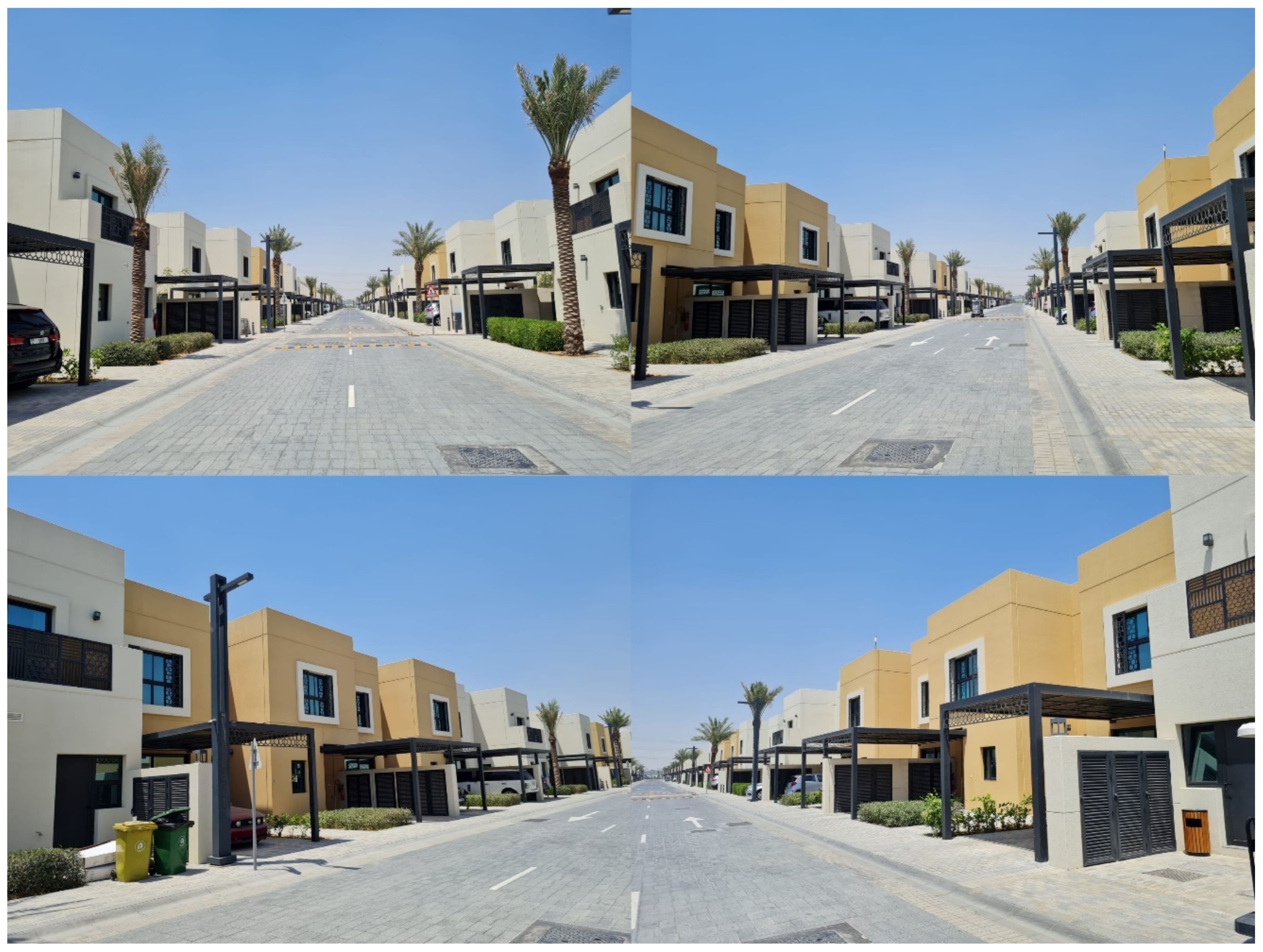
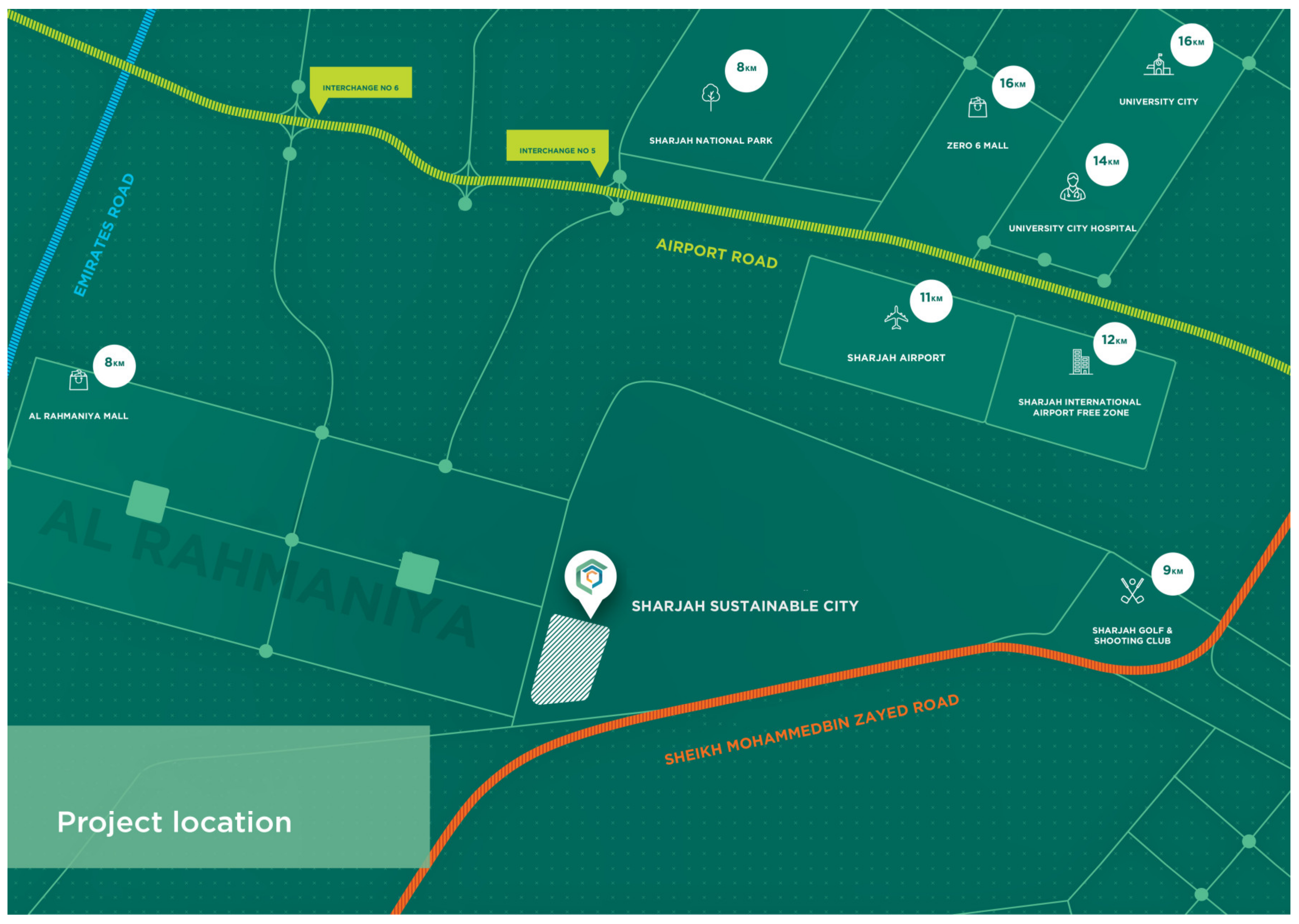
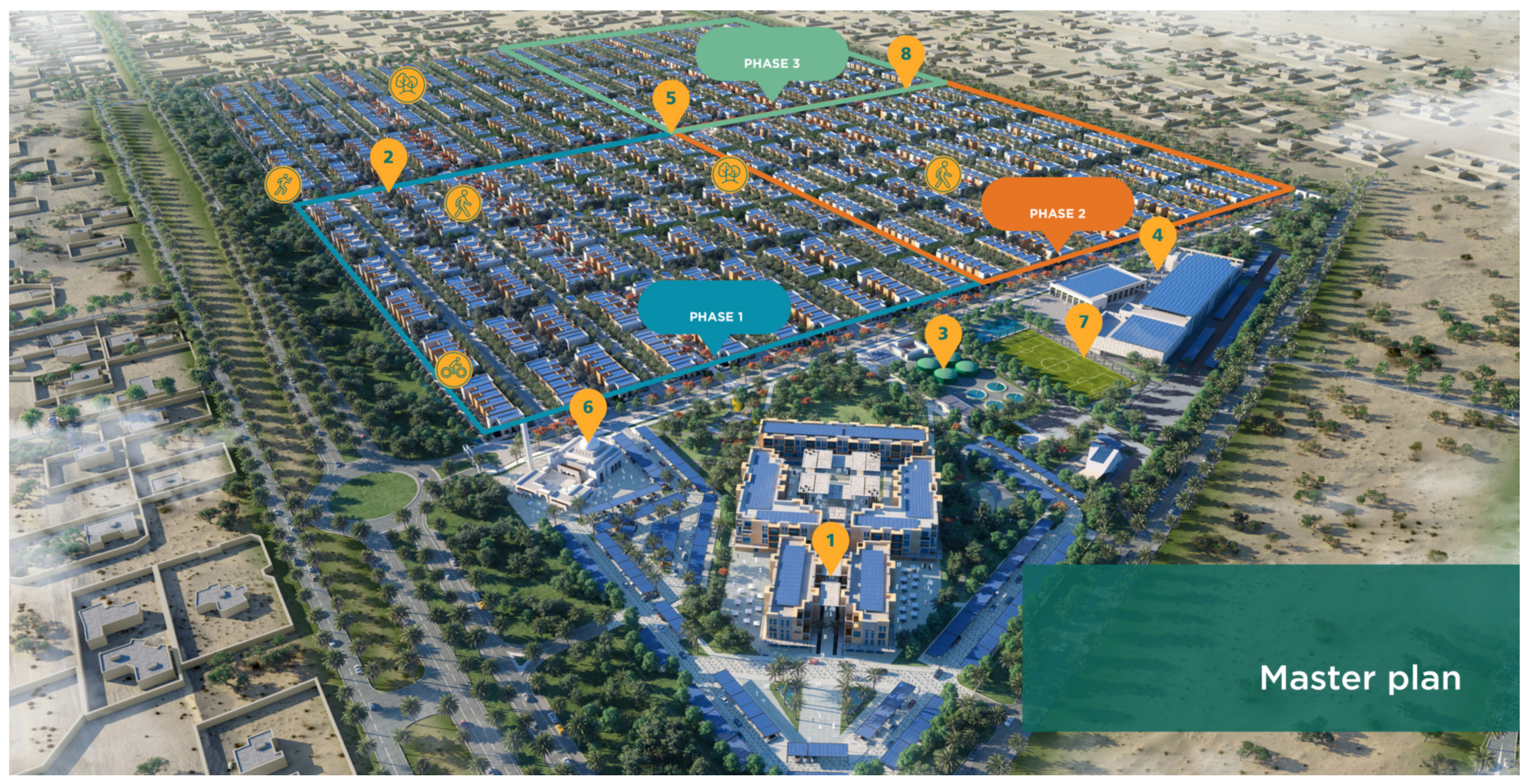
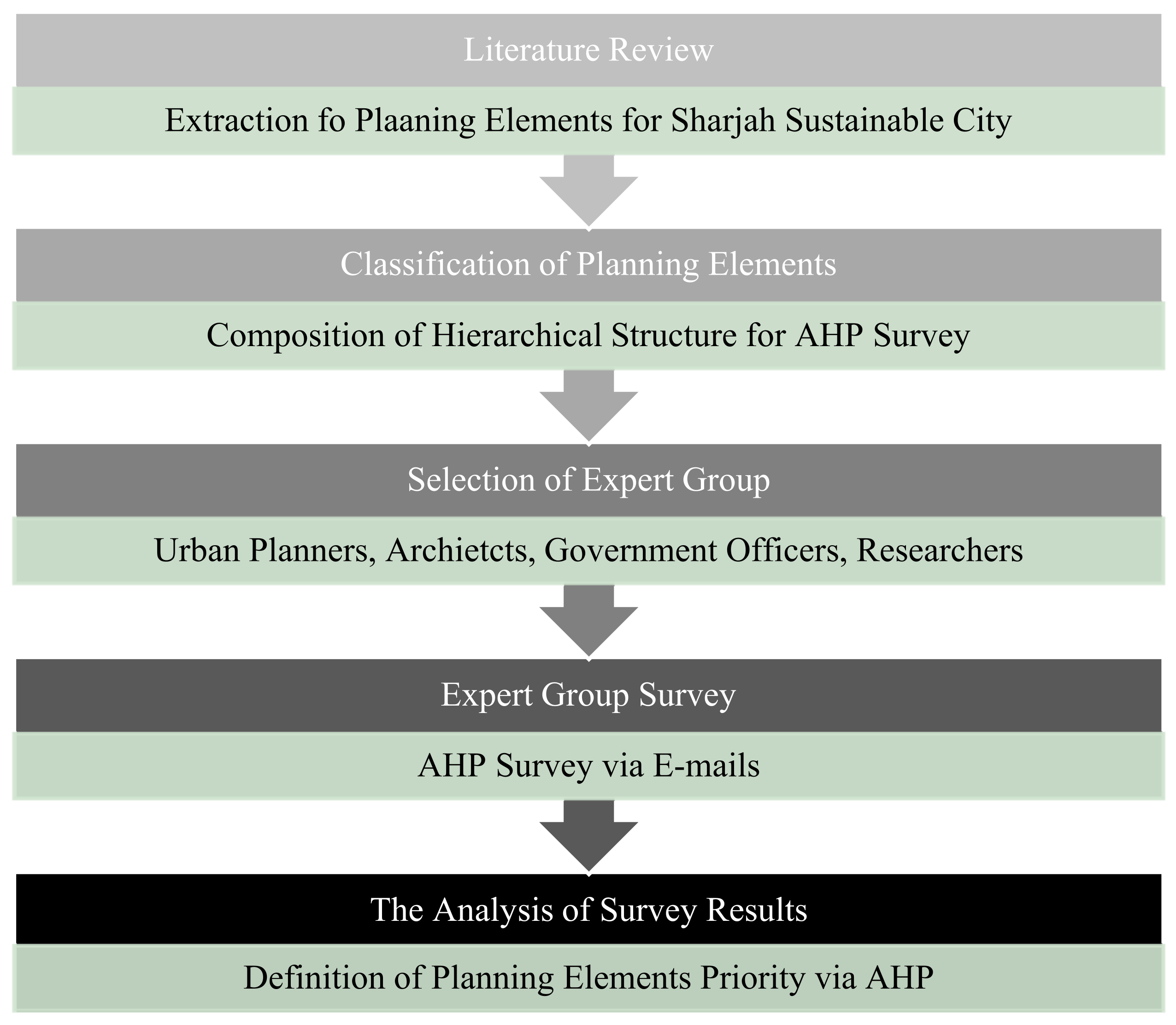
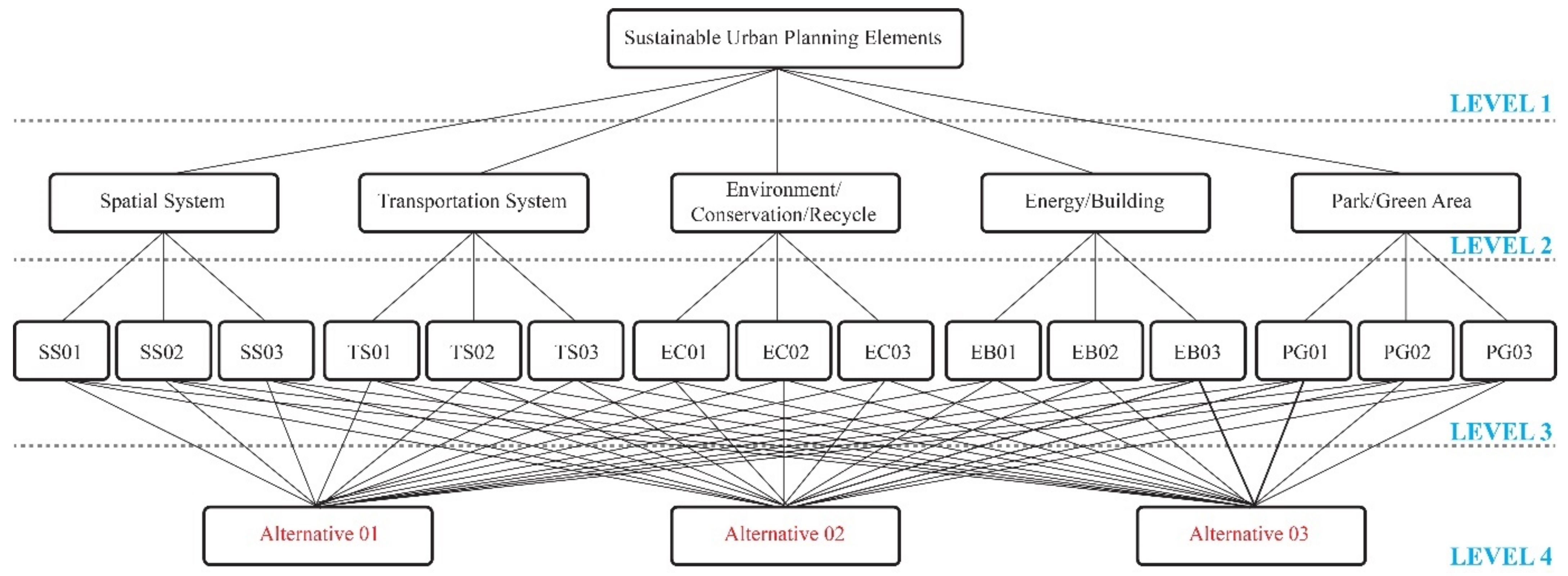
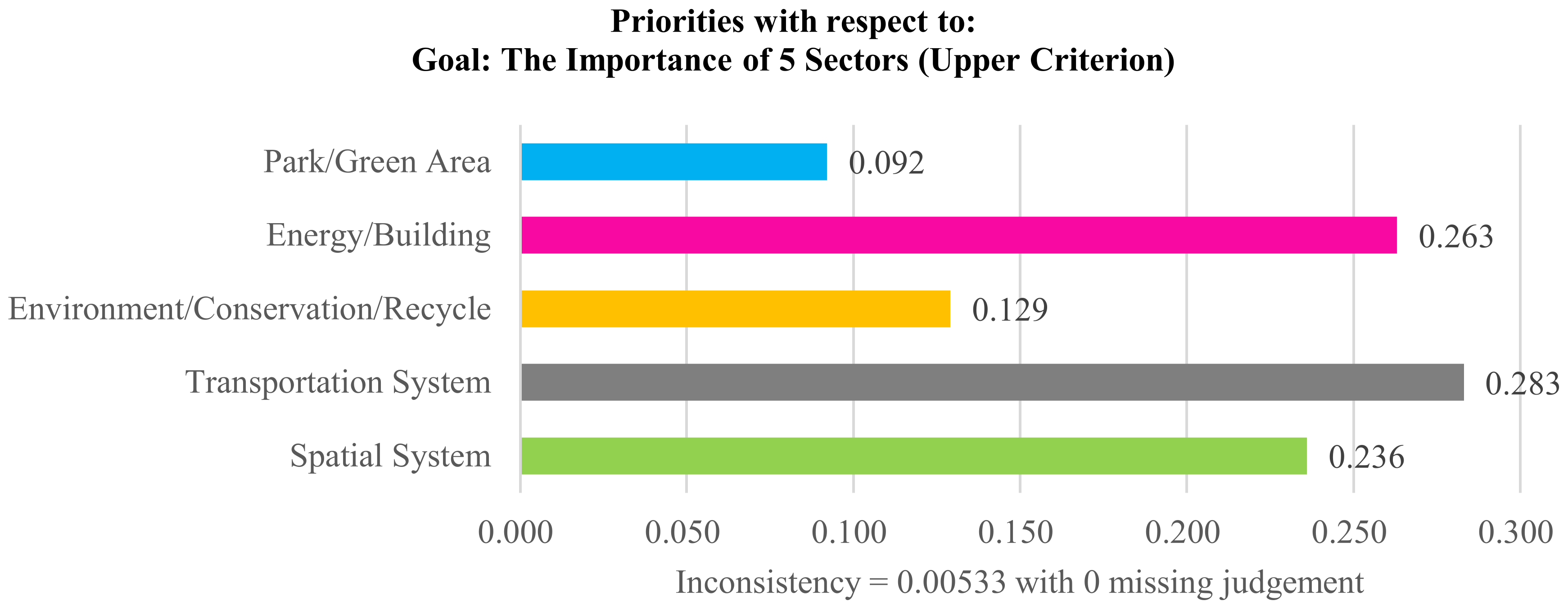
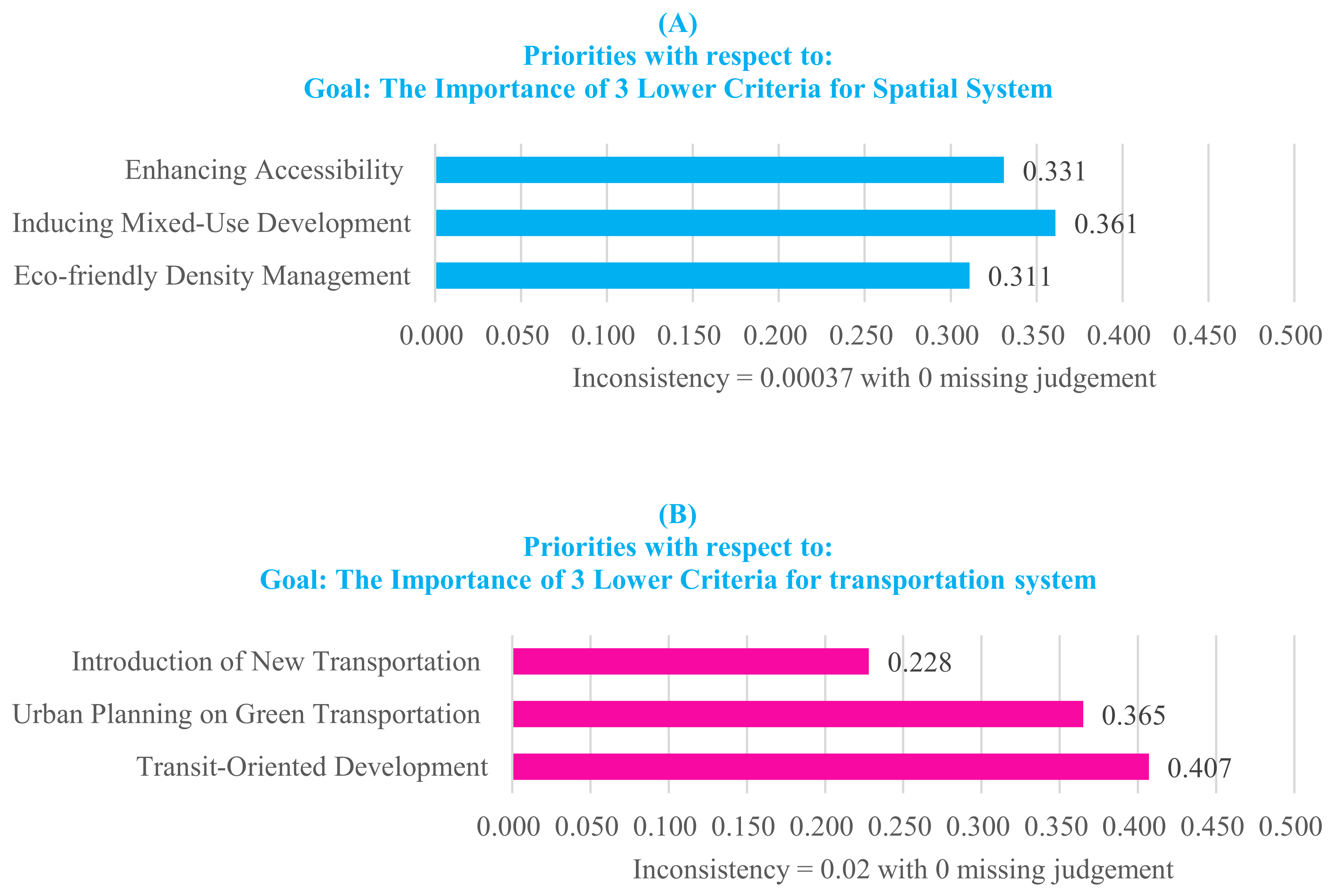
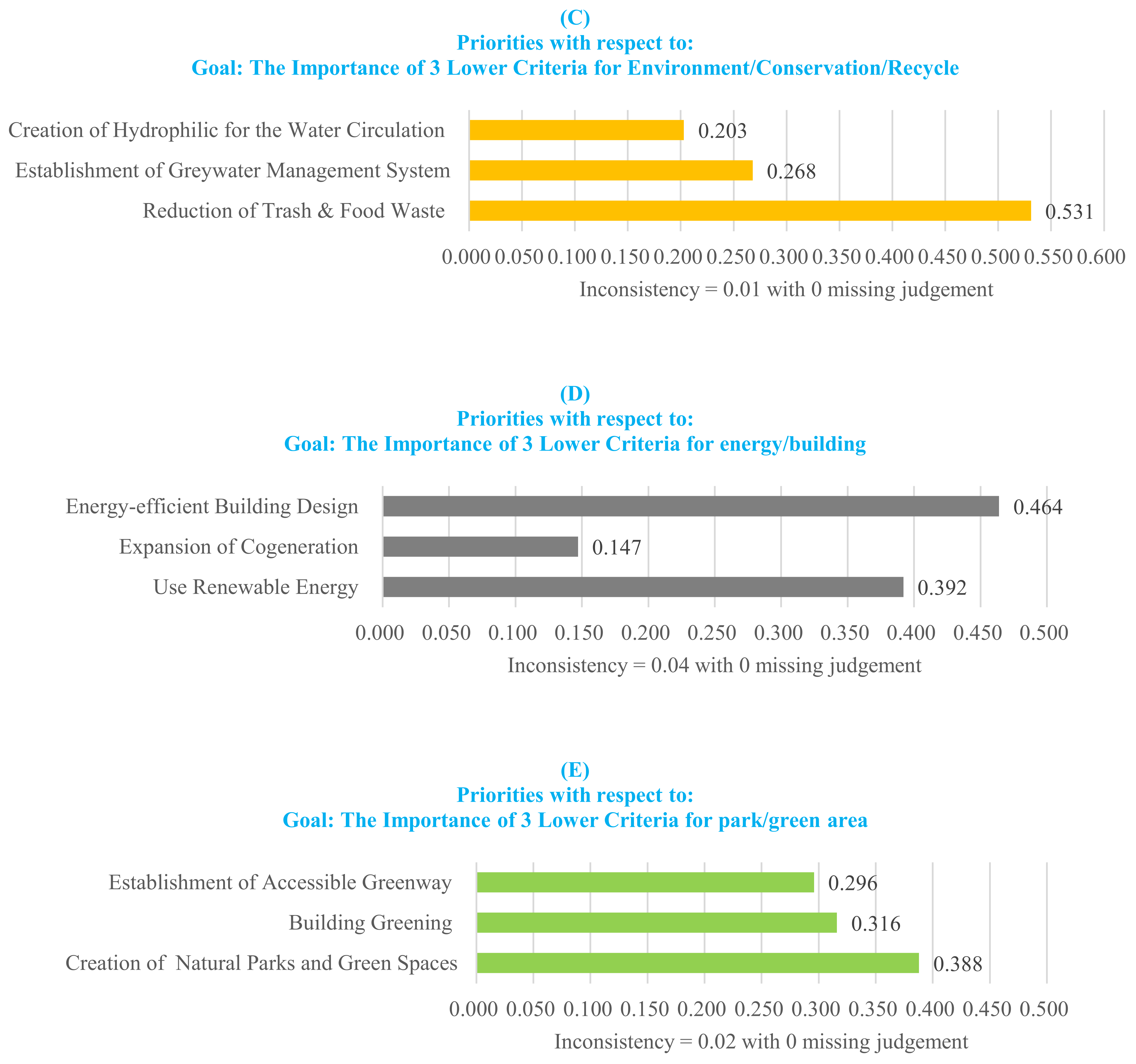
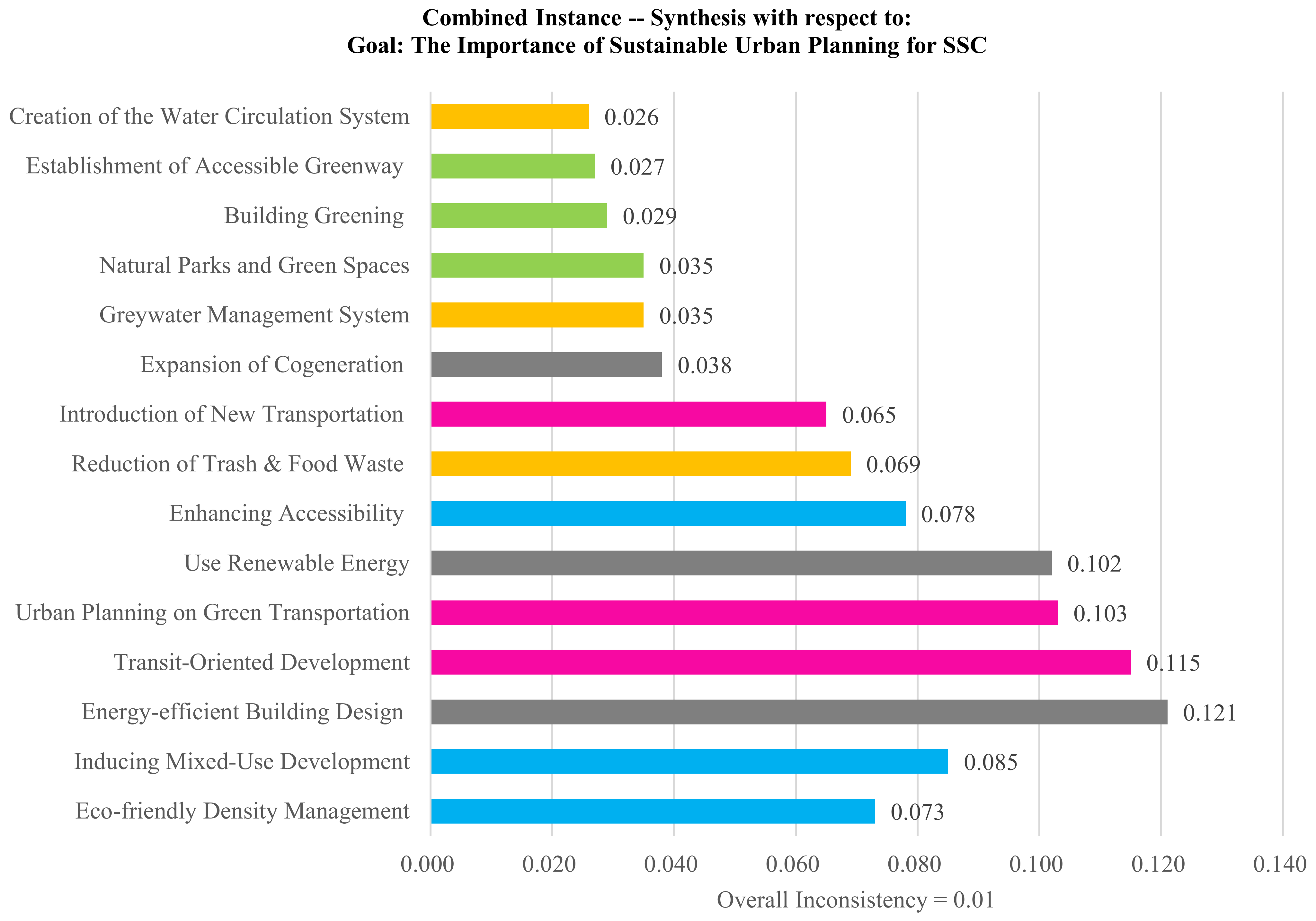
| Planning Elements | Previous Studies | |||||
|---|---|---|---|---|---|---|
| Wang et al. (2014) [32] | Liu et al. (2012) [33] | Ying and Yue (2017) [36] | Topi et al. (2016) [38] | Yildiz et al. (2019) [42] | Frequency | |
| Eco-friendly Density Management | ○ | ○ | ○ | ○ | 4 | |
| Inducing Mixed-Use Development | ○ | ○ | 2 | |||
| Enhancing Accessibility (Securing the Adequacy of the Neighborhood Area) | ○ | ○ | 2 | |||
| Arrangement of Houses/Facilities in Consideration of Sun Orientation | ○ | 1 | ||||
| Public Transportation-Oriented Development | ○ | ○ | ○ | 3 | ||
| Urban Planning on Green Transportation (Bicycles and Pedestrian Roads) | ○ | ○ | ○ | ○ | ○ | 5 |
| Introduction of New Transportation (Monorail, Electric Vehicle, etc.) | ○ | ○ | 2 | |||
| Promotion of Traffic Calming Techniques around Residential Areas and Schools | ○ | 1 | ||||
| Reduction in Trash and Food Waste and Establishment of a Recycling System | ○ | ○ | ○ | ○ | 4 | |
| Building a Low-Carbon Water Supply System | ○ | 1 | ||||
| Establishment of a Greywater Management System | ○ | ○ | ○ | ○ | 4 | |
| Creation of Hydrophilic for the Water Circulation System | ○ | ○ | ○ | 3 | ||
| Use Renewable Energy (Solar Power, Geothermal Heat, and Wind Power) | ○ | ○ | 2 | |||
| Expansion of Cogeneration (Energy and Cooling supply) | ○ | 1 | ||||
| Energy-efficient Building Design (Insulation and Natural Light) | ○ | ○ | ○ | ○ | 4 | |
| Creation of Low-Carbon Natural Parks and Green Spaces | ○ | ○ | ○ | ○ | ○ | 5 |
| Prevention of Heat Islands by Expanding Wind Paths | ○ | ○ | ○ | 3 | ||
| Building Greening (Green Roof, Green Wall, and Green Artificial Ground) | ○ | ○ | ○ | 3 | ||
| Establishment of Accessible Greenways and Green Matrix in residential Areas | ○ | ○ | ○ | ○ | 4 | |
| Criterion 1 (Sector) | Criterion 2 (Planning Elements) | |
|---|---|---|
| Spatial System | SS01 | Eco-friendly Density Management |
| SS02 | Inducing Mixed-Use Development | |
| SS03 | Enhancing Accessibility (Securing the Adequacy of the Neighborhood Area) | |
| Transportation System | TS01 | Public Transportation-Oriented Development |
| TS02 | Urban Planning on Green Transportation (Bicycles and Pedestrian Roads) | |
| TS03 | Introduction of New Transportation (Monorail, Electric Vehicle, etc.) | |
| Environment/Conservation/Recycle | EC01 | Reduction of Trash and Food Waste and Establishment of a Recycling System |
| EC02 | Establishment of a Greywater Management System | |
| EC03 | Creation of Hydrophilic for the Water Circulation System | |
| Energy/Building | EB01 | Use Renewable Energy (Solar Power, Geothermal Heat, and Wind Power) |
| EB02 | Expansion of Cogeneration (Energy and Cooling supply) | |
| EB03 | Energy-efficient Building Design (Insulation and Natural Light) | |
| Park/Green Area | PG01 | Creation of Low-Carbon Natural Parks and Green Spaces |
| PG02 | Building Greening (Green Roof, Green Wall, and Green Artificial Ground) | |
| PG03 | Establishment of Accessible Greenways and Green Matrix in residential Areas |
| Classification | Urban Planner | Architects | Officers | Researchers | Total |
|---|---|---|---|---|---|
| Survey Participants | 42 | 32 | 18 | 26 | 118 |
| Percentage (%) | 35.6 | 27.1 | 15.3 | 22.0 | 100 |
| Responded Participants | 34 | 26 | 15 | 21 | 96 |
| Percentage (%) | 35.4 | 27.1 | 15.6 | 21.9 | 100 |
Disclaimer/Publisher’s Note: The statements, opinions and data contained in all publications are solely those of the individual author(s) and contributor(s) and not of MDPI and/or the editor(s). MDPI and/or the editor(s) disclaim responsibility for any injury to people or property resulting from any ideas, methods, instructions or products referred to in the content. |
© 2023 by the authors. Licensee MDPI, Basel, Switzerland. This article is an open access article distributed under the terms and conditions of the Creative Commons Attribution (CC BY) license (https://creativecommons.org/licenses/by/4.0/).
Share and Cite
Jung, C.; Awad, J. Sharjah Sustainable City: An Analytic Hierarchy Process Approach to Urban Planning Priorities. Sustainability 2023, 15, 8217. https://doi.org/10.3390/su15108217
Jung C, Awad J. Sharjah Sustainable City: An Analytic Hierarchy Process Approach to Urban Planning Priorities. Sustainability. 2023; 15(10):8217. https://doi.org/10.3390/su15108217
Chicago/Turabian StyleJung, Chuloh, and Jihad Awad. 2023. "Sharjah Sustainable City: An Analytic Hierarchy Process Approach to Urban Planning Priorities" Sustainability 15, no. 10: 8217. https://doi.org/10.3390/su15108217
APA StyleJung, C., & Awad, J. (2023). Sharjah Sustainable City: An Analytic Hierarchy Process Approach to Urban Planning Priorities. Sustainability, 15(10), 8217. https://doi.org/10.3390/su15108217









